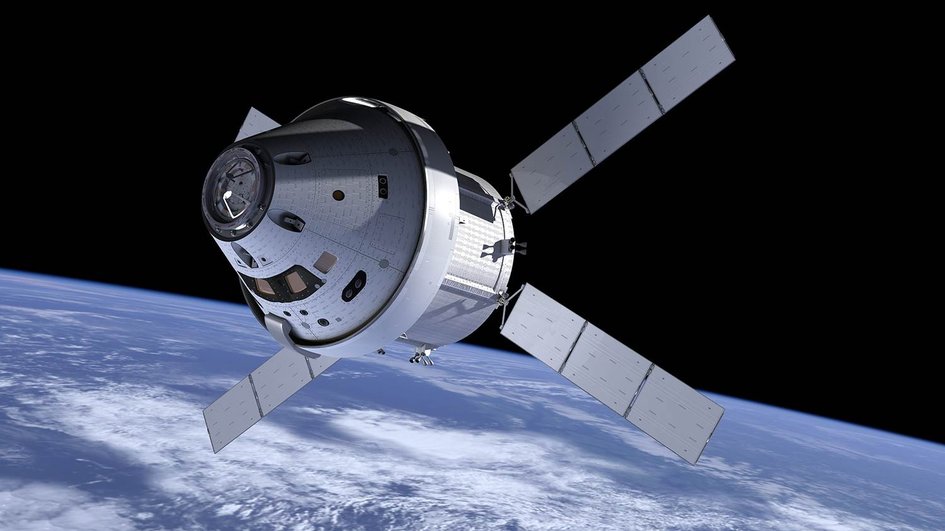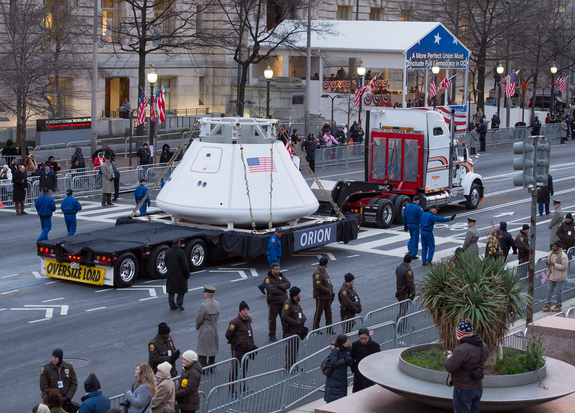
The first Orion mission will be an uncrewed lunar flyby in 2017, returning to Earth’s atmosphere at 11 km/s – the fastest reentry ever.
Credit: NASA
Lockheed Martin Space Systems Co. is an American aerospace company. It is the prime contractor for the Orion Multipurpose Crew Vehicle that is intended to carry astronauts into the solar system beyond Earth orbit.
The first uncrewed test of Orion took place in December 2014. The company hopes to launch crewed missions in the 2020s. With Orion, NASA hopes to move crews to other locations in the solar system, such as an asteroid or Mars.
Exploiting space experience
Lockheed Martin is an experienced hand in aerospace missions. The company’s aircraft have set records and achieved milestones in aviation and space exploration for about 100 years:
- In 1928, the first nonstop transcontinental flight was completed in a Lockheed Vega, a four-passenger wooden monoplane.
- In 1930, Charles Lindbergh and his wife, Anne Morrow Lindbergh, set a transcontinental speed record in a Lockheed Sirius.
- In 1932, Amelia Earhart made her solo transatlantic flight in a Lockheed Vega.
- In 1955, the company’s top-secret U2 reconnaissance aircraft made its first flight.
- In 1957, the first Vanguard rocket was launched.
- In 1959, Lockheed’s Agena rocket launches the United States’ first satellite, Explorer 1 , into orbit.
- In 1974, Lockheed’s SR-71 Blackbird spy plane sets a speed record — 3 hours 45 minutes from London to Los Angeles.
More recently, Lockheed built the external tank for the space shuttle and is part of the joint company United Space Alliance, which maintained the shuttle. Lockheed has also built several Mars spacecraft, including Mars Phoenix , which explored the Red Planet’s south pole. The company also constructed Mars Reconnaissance Orbiter , which serves as a communications relay for the Curiosity and Opportunity rovers.

The Orion space capsule is seen as it rolls down Pennsylvania Avenue during the inaugural parade honoring President Barack Obaama, Monday Jan. 21, 2013, in Washington.
Credit: NASA/Carla Cioffi
Orion contract awarded
The company faced stiff competition for the lucrative Orion contract when it was announced in 2004. Lockheed went toe-to-toe with Northrop Grumman (most famous for the Apollo lunar lander) and Boeing in winning the contract. It was valued at up to $8.15 billion when it was awarded in August 2006.
Credit: Karl Tate, SPACE.com contributor
At the time, a spokeswoman stated the employees were “humbled and excited” about winning the contract. “Work already is under way and we are fully focused on the vital tasks that lie ahead to meet NASA’s requirements for the program,” stated Joanne Maguire, executive vice president of Lockheed Martin Space Systems, in an Aug. 31, 2006 news release.
But Orion’s future fell into doubt in 2010, after President Obama cancelled the planned Constellation program. By that point, NASA had already spent $5 billion on the development. NASA hinted the spacecraft could be repurposed in April 2011. One month later, the agency unveiled a new plan to develop a Multi-Purpose Crew Vehicle based on the Orion spacecraft designs.
“We made this choice based on the progress that’s been made to date,” Doug Cooke, associate administrator for NASA’s Exploration Systems Mission Directorate in Washington, D.C., said to reporters on May 24, 2011. “It made the most sense to stick with it (the Orion design).” [Infographic: Orion Explained: NASA’s Multi-Purpose Crew Vehicle ]
The company’s largest setback with Orion came in November 2012, when engineers discovered cracks in the spacecraft after performing a test that subjected the spacecraft to high pressure.
“The cracks are in three adjacent, radial ribs of this integrally machined, aluminum bulkhead,” NASA’s Rachel Kraft wrote in an email to Space.com at the time. “This hardware will be repaired and will not need to be remanufactured.”
A flexible craft
Orion’s resemblance to the Apollo command module is only skin-deep. Orion can carry two to six astronauts instead of three, and has an exponential capability in computer power. Further, its heat shield is constructed of newer substances .
The first space-based test of Orion took place Dec. 5, 2014. The spacecraft passed all major objectives. It orbited the Earth twice and re-entered the atmosphere at a velocity not seen since the Apollo moon era of the 1960s and 1970s.
The flight was called the Orion Exploration Flight Test-1. Riding aboard a United Launch Alliance Delta 4-Heavy rocket, Orion rocketed to orbit to an altitude of more than 3,600 miles (5,800 kilometers) above Earth – about 15 times the altitude of the International Space Station.
That high altitude led to a high-speed re-entry of 20,000 mph (32,000 kph). This was supposed to demonstrate the strength of the heat shield when bringing back astronauts from destinations such as an asteroid or the moon.
“We are going to get about 84 percent of a lunar entry velocity, which is really going to stress the heat shield, which is exactly what we’re trying to do,” said Mark Geyer, NASA’s Orion program manager, in 2012 .
In the long term, Orion will launch aboard NASA’s Space Launch System, which is a heavy-lift rocket still being developed. The two systems should have their first flight test together in 2018, when SLS will propel Orion into space for an uncrewed flight around the moon. (Riding along with Orion will be 13 CubeSats to explore deep space.) Human flights are expected by 2023, although a 2021 launch date is possible.
Additional resources
Comments are closed.